|
|
|
 |
IstanbulThe god and human, nature and art are together in there, they have created such a perfect place that it is valuable to see." Lamartine's famous poetic line reveals his love for Istanbul, describing the embracing of two continents, with one arm reaching out to Asia and the other to Europe.
Istanbul, once known as the capital of capital cities, has many unique features. It is the only city in the world to straddle two continents, and the only one to have been a capital during two consecutive empires - Christian and Islamic. Once was capital of the Ottoman Empire, Istanbul still remains the commercial, historical and cultural pulse of Turkey, and its beauty lies in its ability to embrace its contradictions. Ancient and modern, religious and secular, Asia and Europe, mystical and earthly all co-exist here.
Its variety is one of Istanbul's greatest attractions: The ancient mosques, palaces, museums and bazaars reflect its diverse history. The thriving shopping area of Taksim buzzes with life and entertainment. And the serene beauty of the Istanbul strait, Princes Islands and parks bring a touch of peace to the otherwise chaotic metropolis.
Districts
Adalar, Avcilar, Bagcilar, Bahçelievler, Bakirköy, Besiktas, Bayrampasa, Beykoz, Beyoglu, Eminönü, Eyüb, Fatih, Gaziosmanpasa, Kadiköy, Kâgithane, Kartal, Küçükçekmece, Pendik, Sariyer, Sisli, Ümraniye, Üsküdar, Zeytinburnu, Büyükçekmece, Çatalca, Silivri, Sile, Esenler, Güngören, Maltepe, Sultanbeyli, and Tuzla.
The Istanbul strait
Golden Horn:
This horn-shaped estuary divides European Istanbul. One of the best natural harbours in the world, it was once the centre for the Byzantine and Ottoman navies and commercial shipping interests. Today, attractive parks and promenades line the shores, a picturesque scene especially as the sun goes down over the water. At Fener and Balat, neighbourhoods midway up the Golden Horn, there are entire streets filled with old wooden houses, churches, and synagogues dating from Byzantine and Ottoman times. |
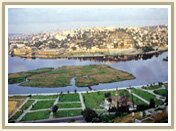 |
| The Orthodox Patriarchy resides at Fener and a little further up the Golden Horn at Eyup, are some wonderful examples of Ottoman architecture. Muslim pilgrims from all over the world visit Eyup Mosgue and Tomb of Eyup, the Prophet Mohammed's standard bearer, and it is one of the holiest places in Islam. The area is a still a popular burial place, and the hills above the mosque are dotted with modern gravestones interspersed with ornate Ottoman stones. The Pierre Loti Cafe, at the top of hill overlooking the shrine and the Golden Horn, is a wonderful place to enjoy the tranquility of the view. |
Beyoglu and Taksim:
Beyoglu is an interesting example of a district with European-influenced architecture, from a century before. Europe's second oldest subway, Tunel was built by the French in 1875, must be also one of the shortest - offering a one-stop ride to start of Taksim. Near to Tunel is the Galata district, whose Galata Tower became a famous symbols of Istanbul, and the top of which offers a tremendous 180 degree view of the city.
|
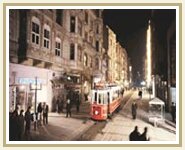 |
From the Tunel area to Taksim square, is one of the city's focal points for shopping, entertainment and urban promenading: Istiklal Caddesi is a fine example of the contrasts and compositions of Istanbul; fashion shops, bookshops, cinemas, markets, restaurants and even hand-carts selling trinkets and simit (sesame bread snack) ensure that the street is packed throughout the day until late into the night. The old tramcars re-entered into service, which shuttle up and down this fascinating street, and otherwise the street is entirely pedestrianised. There are old embassy buildings, Galatasaray High School, the colourful ambience of Balik Pazari (Fish Bazaar) and restaurants in Çiçek Pasaji (Flower Passage). Also on this street is the oldest church in the area, St Mary's Draperis dating back to 1789, and the Franciscan Church of St Antoine, demolished and then rebuilt in 1913.
The street ends at Taksim Square, a big open plaza, the hub of modern Istanbul and always crowded, crowned with an imposing monument celebrating Ataturk and the War of Independence. The main terminal of the new subway is under the square, adjacent is a noisy bus terminal, and at the north end is the Ataturk Cultural Centre, one of the venues of the Istanbul Theatre Festival. Several five-star hotels are dotted around this area, like the Hyatt, Intercontinental and Hilton (the oldest of its kind in the city). North of the square is the Istanbul Military Museum.
Taksim and Beyoglu have for centuries been the centre of nightlife, and now there are many lovely bars and clubs off Istiklal Cadesi, including some of the only gay venues in the city. Beyoglu is also at the centre of the more bohemian arts scene. |
|
Sultanahmet:
Many places of tourist interest are concentrated in Sultanahmet, in heart of the Imperial Centre of the Ottoman Empire. The most important places in this area, all of which are described in detail in the "Places of Interest" section, are Topkapi Palace, Aya Sofya, Sultanahmet Mosgue (the Blue Mosque), the Hippodrome, Kapali Carsi (Covered Market), Yerebatan Sarnici and the Museum of Islamic Art.
In addition to this wonderful selection of historical and architectural sites, Sultanahmet also has a large concentration of carpet and souvenir shops, hotels and guesthouses, cafes, bars and restaurants, and travel agents. |
Ortaköy:
Ortakoy was a resort for the Ottoman rulers because of its attractive location on the Istanbul strait, and is still a popular spot for residents and visitors. The village is within a triangle of a mosque, church and synagogue, and is near çiragan Palace, Kabatas High School, Feriye, Princess Hotel.
The name Ortaköy reflects the university students and teachers who would gather to drink tea and discuss life, when it was just a small fishing village. These days, however, that scene has developed into a suburb with an increasing amount of expensive restaurants, bars, shops and a huge market. The fishing, however, lives on and the area is popular with local anglers, and there is now a huge waterfront tea-house which is crammed at weekends and holidays. |
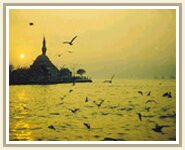 |
| The Orthodox Patriarchy resides at Fener and a little further up the Golden Horn at Eyup, are some wonderful examples of Ottoman architecture. Muslim pilgrims from all over the world visit Eyup Mosgue and Tomb of Eyup, the Prophet Mohammed's standard bearer, and it is one of the holiest places in Islam. The area is a still a popular burial place, and the hills above the mosque are dotted with modern gravestones interspersed with ornate Ottoman stones. The Pierre Loti Cafe, at the top of hill overlooking the shrine and the Golden Horn, is a wonderful place to enjoy the tranquility of the view. |
|
| |
Üsküdar:
Relatively unknown to tourists, the suburb of Üsküdar, on the Asian side of the Istanbul strait, is one of the most attractive suburbs. Religiously conservative in its background, it has a tranquil atmosphere and some fine examples of imperial and domestic architecture.
The iskele, or Mihrimah Mosgue is opposite the main ferry pier, on a high platform with a big covered porch in front, often occupied by older local men watching life around them. Opposite this is Yeni Valide Mosgue, built in 1710, and the Valide Sultan's green tomb rather like a giant birdcage. The Çinili Mosque takes its name from the beautiful tiles which decorate the interior, and was built in 1640.
Apart from places of religious interest, Üsküdar is also well known as a shopping area, with old market streets selling traditional local products, and a good fleamarket with second hand furniture. There are plenty of good restaurants and cafes with a great views of the Istanbul strait and the rest of the city, along the quayside. In the direction of Haydarpasa is the Karaca Ahmet Cemetery, which is the largest Muslim graveyard in Istanbul. The front of the Çamlica hills lie at the ridge of area and also offer great panoramic views of the islands and river.
Kadiköy:
Further down to the south along, the Istanbul strait towards the Marmara sea, Kadiköy has developed into a lively area with up-market shopping, eating and entertainment making it popular especially with wealthy locals. Once prominent in the history of Christianity, the 5th century hosted important consul meetings here, but there are few reminders of that age. It is one of the improved districts of Istanbul over the last century, and fashionable area to promenade along the waterfront in the evenings, especially around the marinas and yacht clubs.
Bagdat Caddesi is one of the most trendy - and label-conscious - fashion shopping streets, and for more down-to-earth goods, the Gen Azim Gündüz Caddesi is the best place for clothes, and the bit pazari on Ozelellik Sokak is good for browsing through junk. The Benadam art gallery remains in Moda district with many other foreing cusines, restaurants and cafes.
Haydarpasa:
To the north of Kadikoy is Haydarpasa, and the train station built in 1908 with Prussian-style architecture which was the first stop along the Baghdad railway. Now it is the main station going to eastbound destinations both within Turkey, and international. There are tombs and monuments dedicated to the English and French soldiers who lost their lives during the Crimean War (1854-56), near the military hospital. The north-west wing of the 19th Century Selimiye Barracks once housed the hospital, used by Florence Nightingale to care for soldiers, and remains to honour her memory.
Polonezköy:
Polonezköy, although still within the city, is 25 km. away from the centre and not easy to reach by public transport. Translated as "village of the Poles", the village has a fascinating history: It was established in 1848 by Prince Czartorisky, leader of the Polish nationals who was granted exile in the Ottoman Empire to escape oppression in the Balkans. During his exile, he succeeded in establishing a community of Balkans, which still survives, on the plot of land sold to him by a local monastery.
Since the 1970s the village has become a popular place with local Istanbulites, who buy their pig meat there (pig being forbidden under Islamic law and therefore difficult to get elsewhere). All the Poles have since left the village, and the place is inhabited now by wealthy city people, living in the few remaining Central European style wooden houses with pretty balconies.
What attracts most visitors to Polonezkoy is its vast green expanse, which was designated Istanbul's first national park, and the walks though forests with streams and wooden bridges. Because of its popularity, it gets crowded at weekends and the hotels are usually full.
Kilyos:
Kilyos is the nearest beach resort to the city, on the Black Sea coast on the European side of the Istanbul strait. Once a Greek fishing village, it has quickly been developed as a holiday-home development, and gets very crowded in summer. Because of its ease to get there, 25km and plenty of public transport, it is good for a day trip, and is a popular weekend getaway with plenty of hotels, and a couple of campsites.
Sile:
A pleasant, small holiday town, Sile lies 50km from Üsküdar on the Black Sea coast and some people even live there and commute into Istanbul. The white sandy beaches are easily accessible from the main highway, lying on the west, as well as a series of small beaches at the east end. The town itself if perched on a clifftop over looking the bay tiny island. There is an interesting French-built black-and-white striped lighthouse, and 14th century Genoese castle on the nearby island. Apart from its popular beaches, the town is also famous for its craft; Sile bezi, a white muslin fabric a little like cheesecloth, which the local women embroider and sell their products on the street, as well as all over Turkey.
The town has plenty of accommodation available, hotels, guest houses and pensions, although can get very crowded at weekends and holidays as it is very popular with people from Istanbul for a getaway, especially in the summer. There are small restaurants and bars in the town.
Prince's Islands:
Also known as Istanbul Islands, there are eight within one hour from the city, in the Marmara Sea. Boats ply the islands from Sirkeci, Kabatas and Bostanci, with more services during the summer. These islands, on which monasteries were established during the Byzantine period, was a popular summer retreat for palace officials. It is still a popular escape from the city, with wealthier owning summer houses.
|
| |
Büyükada:
The largest and most popular one in Istanbul is Büyükada (the Great Island). Large wooden mansions still remain from the 19th century when wealthy Greek and Armenian bankers built them as a holiday villas. The island has always been a place predominantly inhabited by minorities.
Buyukada has long had a history of people coming here in exile or retreat; its most famous guest being Leon Trotsky, who stayed for four years writing 'The History of the Russian Revolution'. The monastery of St George also played host to the granddaughter of Empress Irene, and the royal princess Zoe, in 1012. |
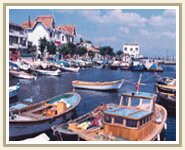 |
The island consists of two hills, both surmounted by monasteries, with a valley between. Motor vehicles are banned, so getting around the island can be done by graceful horse and carriage, leaving from the main square off Isa Celebi Sokak. Bicycles can also be hired.
The southern hill, Yule Tepe, is the quieter of the two and also home of St George's Monastery. It consists of a series of chapels on three levels, the site of which is a building dating back to the 12th century. In Byzantine times it was used as an asylum, with iron rings on the church floors used to restrain patients. On the northern hill is the monastery Isa Tepe, a 19th century house.
The entire island is lively and colourful, with many restaurants, hotels, tea houses and shops. There are very big well-kept houses, trim gardens, and pine groves, as well as plenty of beach and picnic areas.
Burgazada It is a smaller and less infrastructured for tourists.The famous Turkish novelist, Sait Faik Abasiyanik lived there, and his house has been turned into a museum dedicated to his work, and retains a remarkable tranquil and hallowed atmosphere. |
|
Heybeliada:
Island of the Saddlebag', because of its shape, is loved for its natural beauty and beaches. It also has a highly prestigious and fashionable watersports club in the northwest of the island. One of its best-known landmarks is the Greek Orthodox School of Theology, with an important collection of Byzantine manuscripts. The school sits loftily on the northern hill, but permission is needed to enter, from the Greek Orthodox Patriarchate in Fener. The Deniz Harp Okulu, the Naval High School, is on the east side of the waterfront near the jetty, which was originally the Naval War Academy set up in 1852, then a high school since 1985. Walking and cycling are popular here, plus isolated beaches as well as the public Yöruk Beach, set in a magnificent bay.
There are plenty of good local restaurants and tea houses, especially along Ayyildiz Caddesi, and the atmosphere is one of a close community.
|
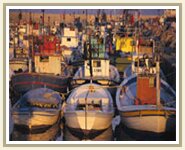 |
|
| |
Don't Leave Without
- Seeing two of the master pieces of religious art of Istanbul, Süleymaniye Mosque and Sultanahmet Mosque,
- Visiting Hagia Sophia and Museum,
- Visiting Topkapi Palace, Dolmabahçe Palace and Rumeli Hisari,
- Having a ship voyage at Bosporus and Islands,
- Watching Istanbul panorama from Galata Tower and Pierre Loti,
- Following art and cultural activities,
- Being curious and seeing entertainment life,
- Visiting Ortaköy bazaar,
- Having a tour via phaeton in Büyükada,
- Eating fish in Bosporus, Kumkapi and çiçek bazaar, yogurt in Kanlica, and profiterole in Beyoglu,
- Buying carpet, jewelry, leather clothes in Kapaliçarsi, and Turkish delight, baklava, pastirma and deserts in Misir Bazaar,
- Shopping in Beyoglu and all mega shopping centers.
How to Get
By Road : Not surprisingly, Istanbul is well connected to every part of Turkey. Buses are frequent and plentiful, and the main coach station (otogar) is at Esenler, on the European side.
There are countless private bus companies, all of whom have a ticket office at the station and the larger ones have offices dotted around town, especially in areas like Taksim, Sultanahmed and Besiktas.
Prices vary slightly regarding quality of the vehicle. There are also departures from Harem, on the Asian side. For journeys further afield, there buses to Greece, Macedonia, Germany, France, Austria, Switzerland, Saudi Arabia, Syria, Iran, Russia, Georgia, Romania, Bulgaria and Jordan.
Bus Station Tel: (+90-212) 658 05 05, 658 10 10, 333 37 63, 310 63 63.
Within the city, public transport is a good way of getting around. There are minibuses, buses, taxis, trams (from Aksaray) a new subway (between Taskim and Levent) and a tiny electric tramcar (Beyoglu to Taksim).
By Rail : Not as popular a mode of transport as buses, with a much smaller network, there are rail connections from Istanbul to Ankara, Izmir and Eastern Anatolian cities. Most of the services are slower than buses, although between the three main cities, there are the mavi tren, mototren or ekspress, which are fast and comfortable.
Reservations are essential for these journeys, and there are several classes of seats and sleepers. International services from Sirkeci (on the European side) and Haydarpasa (Asian side) stations include Vienna, Munich, Budapest, Salonica, (via Eskisehir, Konya, and Gaziantep), Aleppo, (via Tatvan and Van), Tehran, Moscow and Bucharest. Trains heading west leave from Sirkeci, and east from Haydarpasa station.
Sirkeci Information Tel: (+90-212) 527 0050/51. Reservations Tel: (+90-212) 520 6575
Haydarpasa Information Tel: (+90-216) 336 0475/2063. Reservations Tel: (+90-216) 336 4470, 337 8724.
By Boat : Maritime Lines run both the urban and national transport. Marinas also have connections with European ports.
Urban Maritime Transportation runs ships which operate between the following destinations within Istanbul: Kadikoy - Haydarpasa - Karakoy; Eminonu - Uskudar; Eminonu - Kadikoy; Bridge - Yenikoy; Beykoz - Kavaklar; Sirkeci - Bostanci, Bridge - Prince's Islands; Bridge - Yalova; Kabatas - Cinarcik; Bostanci - Cinarcik.
Boats operate from Istanbul to the following Black Sea towns: Zonguldak, Sinop, Samsun, Giresun, Trabzon, Rize, as well as Izmir. Marmara Lines run to Marmara Island, Bandirma and Mudanya.
Useful contacts:
Port Tel : (+90-212) 245 53 66/249 71 78/249 18 96.
Address: TDY Maritime Lines Agency, Rihtim Cad. Kadikoy, Istanbul
Head Office Tel: (+90-212) 245 53 66/249 71 78/249 18 96.
Reservation Tel: (+90-212) 249 92 22/293 74 54
Information Tel: (+90-212) 244 25 02/244 02 07
By Air : Ataturk International Airport is 20 km from city centre. The new airport is the biggest in the country, with the most international flights. There are direct flights to every European capital, and many to Asia, USA and the Middle East.
The domestic terminal has flights to every domestic airport in the country, with several a day to major cities like Ankara and Izmir. Turkish Airlines (THY) is the national carrier.
|
|
| |
|
|
